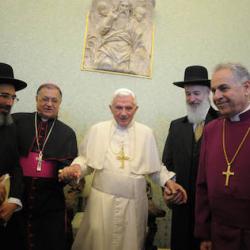In various writings advocating efforts to promote the unity of the church, I haven’t always made clear that unity is not the same as uniformity. This is a brief clarification.
It’s natural, and unobjectionable, that churches manifest the cultural variations of peoples that constitute them. German churches will sing and preach in German, Korean churches in Korean, tribal peoples of South America in their tribal languages. Church music will reflect cultural variations. Even if composers are attuned to the heritage of church music (as they should be), the church music that comes from China over the next several centuries won’t sound like Bach or Buxtehude or Fanny Crosby. (Doubtless in China as in other Asian countries, Crosby is already on the musical menu.) A Protestant battle-cry: Long live the vernacular!
The challenge of sifting legitimate cultural expressions from illegitimate goes back at least to Gregory’s letters to Augustine of Canterbury. The devil is in the details, but at a high level of generality, we can say this: Every culture will have to abandon some of its most cherished ways in order to follow Jesus; but at the same time, conversion should be presented and experienced not primarily as renunciation but as fulfillment. Christian Koreans don’t cease to be Korean, but, united to the Last Adam, they become the Koreans God created them to be.
I hope that over centuries the churches will become more unified liturgically. Some day, I hope, one will have an inkling of what to expect when he or she visits a church on Sunday morning. Someday, we’ll be confident that the service will include confession of sin, song, reading and preaching on the Bible, prayer, the Lord’s Supper, and a benediction, in that order. Someday, we’ll be confident that the service won’t be a disguised concert or a coffee shop. But that doesn’t mean that the liturgies of the church will be completely uniform in every respect. In the church where I currently serve, the Communion of Reformed Evangelical Churches, every local congregation follows the same basic order, including weekly Eucharist. But there are “high” and “low” variations. A liturgically unified catholic church will have a similar range, if only because a city congregation has liturgical resources (musical, for instance) that small rural churches usually lack.
A unified church will confess in unison fundamentals of Christian dogma. Beyond that, a unified church will have a diversity of theological expressions. It has always been so. Even before 1054, East and West breathed different air and traveled different paths. Within the pre-Reformation Western church, there were Franciscans and Dominicans and scholastics and monastic practitioners of spiritual reading. Philip Jenkins has written that African Christians are drawn to Proverbs and the epistle of James; over centuries, churches that meditate deeply on those texts will look quite different from the Paulinocentric churches of European and American Protestantism. In a united church, such regional, national variations would be presented for the edification and correction from the whole church.
This doesn’t mean that a unified church is in fact a disunified church. A church where Africans and Asians sing different hymns to different tunes, or have differences of theological emphases, is quite different from today’s church, where there is no effective doctrinal discipline, where one group closes the Lord’s table to another, and where Christians feel free to ignore, or hate, other Christians because they wear different labels.
Today, we’re cacophonic. The aim isn’t monophony. Rather, the church is called to be polyphonic, a fugal variation on the fugal God we worship (Robert Jenson).















